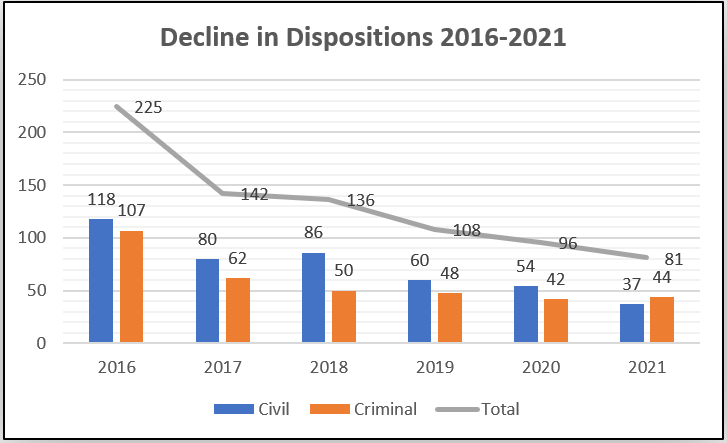Discussing the Declining Caseload at the Court of Appeals
5.4.2023

Over the past several years, the number of cases taken on and decided by the Court of Appeals, New York’s highest court, has declined. In 2016, the court decided 225 cases. This decreased to 142 in 2017, 136 in 2018, 108 in 2019, to 96 cases in 2020. In 2021, the Court of Appeals decided 81 cases – 37 civil and 44 criminal. Dispositions went up slightly in 2022, totaling 91.
An Albany Law Review article by James Pelzer and Thomas Newman – members of the New York State Bar Association’s Committee on Courts of Appellate Jurisdiction – pointed out this recent decrease to the public.
“If you leave out 2021 on the ground that it was influenced by COVID, 2022 is still the lowest… in the recorded history of the statistics of the Court,” said Pelzer.
The Committee hosted a discussion about the decline in caseload and its implications, as well as other factors affecting the Court of Appeals and the Appellate Division – such as the role of concurrences and dissents in the Court, the different processes to grant leave in civil and criminal cases and what makes a case “leaveworthy” – at a discussion at the Bar Center in Albany. The panel was moderated by Pelzer and Denise Hartman, acting justice of the Albany County Supreme Court.
The panelists included:
- Former Court of Appeals Judge Robert Smith
- Former Court of Appeals Judge Eugene F. Pigott, Jr.
- Former Appellate Division, First Department Judge Rosalyn H. Richter
- Albany Law School Professor Patrick Connors
- Appellate Attorney (Civil) Brian Shoot
- Appellate Attorney (Criminal) William Kastin
In the first half of the 1980s, the Court of Appeals had an average annual caseload of over 700. In 1982, the MacCrate Report recommended changing the grant process for civil appeals from appeals as of right to allowing the court discretion in granting appeals. At the time, the civil appeals took over half of the Court’s docket. The Court adopted these changes in 1986, and by the end of Chief Justice Sol Wachtler’s tenure in 1992, the annual caseload had fallen to an average of 345.
“In February of 1991 the Court heard 40 cases over seven days,” said Connors. “In February of 2023 the court heard nine cases over three days. I can’t speak to the cause for that, but it’s very hard for me to believe that the number of cases in our New York State court system that are leaveworthy has diminished to that degree.”
Most panelists agreed that 200 cases a year was a good number – which was the same number suggested in 1899.
The Court of Appeals was created in 1847 as a court of last resort, while the Appellate Division was created in 1894 to review appeals from the lower and trial courts, thus relegating the Court of Appeals to only review questions of law.
Granting Criminal Leave Applications
Criminal dispositions, while on the decline, rose slightly during the tenure of Chief Judge Jonathan Lippman but fell again during Chief Judge Janet DiFiore’s tenure. New York is one of only four states where only one judge decides whether to grant or deny criminal leave applications. Most other states require the full bench to review applications.
“I would get 300 [criminal leave applications], as everyone else would,” said Pigott. “There’s roughly 2,100 a year. I have no idea what the other six got. And they don’t know what I got. So if I’m granting leave in a case, it’s coming whether anybody likes it or not. And if I deny leave, it’s not coming, whether anybody likes it or not… that’s why I think it’s got to change.”
In one instance, Pigott explained, he received a leave application because the judge who was originally assigned had died. The case concerned Anthony Oddone, a college student who had gotten into a fight with a bouncer. The bouncer was seriously injured and died two days later.
Oddone was found guilty of manslaughter and sentenced to 22 years in prison. Whereas the original judge had denied leave, Pigott granted it. The Court of Appeals unanimously reversed the conviction, and his sentence was eventually reduced to time served.
Pigott learned that Oddone later married, had two children and was working in Manhattan. “That’s a whole lot better than being in Sing Sing for the next 15 years,” he said.
Kastin said there’s a perception in many criminal appeals offices that applications are granted based on “luck of the draw” and which judge is assigned to review. “I have a feeling of worry and concern because in the criminal appeals context, the stakes are so high,” he said. “And the way that leave is set up currently, where only one judge can make a determination – as opposed to the civil context when there are many judges viewing a civil leave application – is incredibly troubling because of these consequences. We’re not talking about money. We’re talking about liberty or a fair trial.”
Smith said that there’s resistance to changing the number of judges who review criminal leave applications because of the perception that it would create more work.
During the question-and-answer portion of the discussion forum, Rowan Wilson, the newly installed chief justice of the Court of Appeals, submitted a question online, asking if it would be better for the losing party to pick which judges review their leave applications or get assigned two random judges. The panelists said it would be better to have applications assigned at random so one judge would not get a disproportionate number of leave applications.
Wilson said during his Senate confirmation hearing that he would like to have the Court of Appeals take on more cases.
The full discussion forum is available here.






